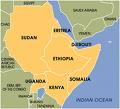Saudi-UAE Military Coalition Expands into the Horn of Africa
Foreign Policy Diary

The Emirati Armed Forces has started to use actively the Eritrean ports. According to our information, at least, three landing craft belonging to the United Arab Emirates were docked in the port of Assab on September 16.
A diplomatic row between Djibouti and UAE took precedence of these developments. On 28 April the UAE consulate in Djibouti was closed after the altercation between Wahib Moussa Kalinleh, the commander of the Djibouti Air Force, and Ali Al Shihi, Vice Consul of the UAE.
Indeed, it was the a formal reason of the departure of the Gulf Cooperation Council troops based on a plot of land that Djibouti had put at its disposal in Haramous in early April to set up its military base. Then Saudi Arabia and UAE redirected their efforts aimed to build a military base on Eritrea.
In turn Eritrea will likely seek to expand its relationships beyond the region in an attempt to break its isolation in the region. Djibouti and Ethiopia have been trying to turn it into a regional rogue state through the African Union. So, from Eritrea’s perspective, accepting Saudi and Emirati cash and resources would be a logical move. Indeed, Eritrea is ready to accept cash and resources from anybody who is ready to provide them.
There was a time when Eritrea supported Yemen’s Houthi fighters and functioned as a transshipment location for Iranian supplies heading to them. Thus, the Saudi and Emirati attempt to involve a new member state into their coalition has 3 goals.
First is to prevent contacts among Eritrea, Iran and Houthi. It will reduce Iran’s possibility to provide supplies to its allies in Yemen.
Second is to use the port of Assab as a local logistics hub, situated relatively close to the conflict. Given the distances that must be traveled over sea to get to Aden from Sudan, Egypt, Saudi Arabia or the United Arab Emirates, the port of Assab is located at a vantage ground.
Third is Saudi Arabia will be able to turn Eritrea into a tool to destabilize the situation in Ethiopia. It’s possible through the monoethnic communities of Ogaden and Oromo controlled by Eritrea. The Ethiopian government is conducting a rough anti-Saudi politics and, de facto, destroying all pro-Saudi Islamist entities.
Alternatively, a recent U.N. report claimed that 400 Eritrean soldiers were deployed to Aden to support the Saudi-led coalition. The Emirati vessels in Assab could either transport the Eritrean troops or ferry equipment and supplies to the Eritrean troops already in Yemen. Assab is becoming a point on the Saudi-led coalition’s main supply route.
In any case, the Saudi and Emirati presence in Eritrea won’t be limited by the Yemeni conflict’s length. According to unconfirmed reports, the UAE took on lease Assab for 30 years. Separately, the UAE is seeking to take on lease a former naval base in Berbera in Somaliland. Thus, the Emirati activity in Eritea is a first step in a big plan to establish a naval base network at the Horn of Africa’s coast.

